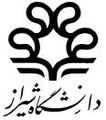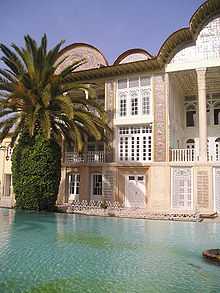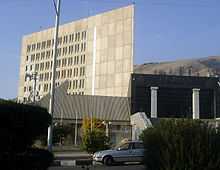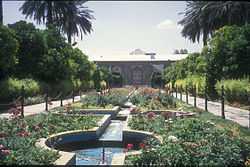Shiraz University
Coordinates: 29°38′23.07″N 52°31′36.3″E / 29.6397417°N 52.526750°E
| Shiraz University | |
|---|---|
|
دانشگاه شيراز Dāneshgāh-e-Shirāz | |
 | |
| Established | 1946 |
| Type | Public |
| Endowment | US$ 80.28 million (December 9, 2013) [1] |
| Chancellor | Dr. Majid Ershad |
| Academic staff | 700 [2] |
| Students | around 20,000 [3] |
| Undergraduates | 11,600 |
| Postgraduates | 5,500 |
| Doctoral students | 1,200 |
| Location |
|
| Campus | Urban |
| Athletics | 12 teams |
| Colors | Dark Blue and White |
| Affiliations |
FUIW IAU |
| Website | www.shirazu.ac.ir |
Shiraz University (Persian: دانشگاه شیراز Dāneshgāh-e-Shirāz), formerly known as Pahlavi University, is a public university located in Shiraz, Iran. It is one of the major universities of Iran, and one of the most prestigious universities in Engineering. Shiraz University has always ranked as Top 5 among Iranian universities and is well respected in Iran. Also IRIB called Shiraz University tough and distinguished.[4]
University of Pennsylvania assist the Iranian government in transforming Shiraz University into the only institution in the Middle East based on American-style higher education. The University of Pennsylvania (Penn) thus became highly influential in shaping many of Pahlavi University's departments and institutions. Shiraz University has the second biggest campus in Iran. The campus was initially designed by American architect, Minoru Yamasaki,[5] who is also famous for designing the World Trade Center.
Shiraz University has pioneered the establishment of doctoral programs in Iran. Presently the university has over 20,000 students, with 200 Bachelor's degree programs (B.A., B.Sc.), 300 Master's degree programs (M.A., M.Sc.), one professional degree program (Doctor of Veterinary Medicine), and 150 Ph.D. programs.
History

Shiraz University traces its roots to 1946, with the establishment of a technical college aimed at training specialists in the medical sciences with a four-year program.
Initially called the High Institute of Health, it developed into a medical school in 1950. In 1953, the Namazi School of Nursing and the Colleges of Agriculture and Arts and Sciences were established.
With the addition of the College of Engineering and College of Veterinary Medicine in 1954, the school was elevated to university-status and named after the reigning Pahlavi dynasty. Other units that were subsequently added were the Dental School in 1969, the Graduate School and College of Electronics in 1969, Dentistry in 1970 and the Colleges of Law and Education in 1977.

In 1960, Mohammed Reza Pahlavi, invited University of Pennsylvania president Gaylord Harnwell to come to Iran and examine Iran's higher education institutions. Harnwell prepared a report at the Shah's request, entitled A Pattern for a New University in Iran, and the Shah subsequently decided that Penn would assist the Iranian government in transforming Pahlavi University[6] into the only institution in the Middle East based on American-style higher education.[7] The University of Pennsylvania (Penn) thus became highly influential in shaping many of Pahlavi University's departments and institutions.[8] Many faculty members from Penn were hence sent to Shiraz to teach and carry out research at the university, and a widespread exchange program was established. The president of the University of Pennsylvania was even awarded an honorary degree in Shiraz in recognition of the help of Penn to Pahlavi University.[9]
After the 1979 Islamic Revolution overthrew the Pahlavi dynasty, drastic changes were implemented at all universities. The name of Pahlavi University was immediately changed to Shiraz University. All universities were closed for three years in a so-called Iran's Cultural Revolution of 1980-1987 to islamize all the universities. Shiraz University is well known as a tough university with low GPA.[10] Even universities like Sharif University of Technology and University of Tehran are not tough to the extent of Shiraz University. Such that, GPA 16 (out of 20) is the highest GPA in some majors. That's why many students of Shiraz University believe their grades do not reflect their academic performance.
Seal
The official seal of the Shiraz University serves as the signature and symbol of authenticity on documents issued by the corporation. Before the Islamic Revolution in Iran, a logo was used as the official logo of Pahlavi University inspired by Persepolis. The logo was inscribed with two words; Wisdom and Effort. However, after the revolution, this logo was also changed.
Language of Instruction
Although the official language of instruction in Shiraz University is Persian, a large number of lecture materials, reference books, homework assignments and even exams are in English. This is especially true for the engineering school where electrical and electronics engineering, computer engineering, mechanical engineering, civil engineering, material science & engineering and chemical engineering programs introduce English textbooks to students as the main references.
Ranking
According to Ministry of Science, Research and Technology (Iran)'s universities ranking published in 2010 and 2011,Shiraz University ranked 6th respectively between 64 and 68 non-medical universities and institution in Iran.It was also one of top three non-technical & non-medical universities along with University of Tehran and Tarbiat Modares University in 2012 ranking.[11]
Shiraz University International Division
Shiraz University International Division is a branch of Shiraz University opened in Qeshm, Iran in February 2005. Shiraz University International Division is only offering graduate and professional programs. By 2012, over 70 Disciplines/Majors are being taught. Organically, all of the instructors are coming from Shiraz University and major universities of Iran.[12]
Athletics
University Athletics Administration is responsible for planning and implementing exercise programs, competitions, and recreational activities of students, faculty members, and employees. Sport facilities of Shiraz University are located mainly at Pardis Complex, Sport Complex of Vahdat Eslami (Shiraz University Recreational Center), and Faculty of Agriculture. The first university horse manege was opened at Shiraz University in 2011.[13] Shiraz University offers 24 sports including Table Tennis, Basketball, Volleyball, Badminton, Track and Field, Squash, Swimming, Handball, Futsal, Soccer, Chess, Weight Lifting, Karate, Judo, Taekwondo, Physical Fitness, Greco-Roman and Freestyle Wrestling, Horse Riding, Cycling, Mountaineering, Shooting, and Exergaming (Active Video Gaming). Health Academy and Exercise Therapy Center was founded for scientific and professional activities in 2012. The center also has a dedicated library with over 3500 books. Over 300 university students have health profiles in the center's database.
Center for Development of Scientific and Professional Ethics
Center for Development of Scientific and Professional Ethics is the first center of its type at Iranian Universities.[14][15][16]
University institutes

- 1966 Naranjestan e Ghavam Museum
- 1969 Geotechnical Institute
- 1970 Shiraz University Computer Center
- 1973 Agricultural Research Center
- 1973 Population Center
- 1974 Solar Energy Center
- 1974 Museum of Natural History and Technology
- 1976 Abu Reyhan-e-Birouni Observatory
- 1977 Center for Atomic Radiation
- 1982 Office for Scientific Cooperation and Consultation
- 1983 Eram Botanical Garden
- 2012 Health Academy and Exercise Therapy Center
Student life
Residence
Shiraz University has 21 dormitories which 15 of them are located at Eram Pardis. These residences are offered to non-domestic students.
Food
Food centers serve lunch and dinner to students, faculty members, and employees. Breakfast is offered to students during serving dinner. Shiraz University has 8 food centers serving lunch from 11:00 to 14:00 and dinner from 17:00 to 19:00. Students can buy weekly tickets from Saturday to Tuesday through the university automation system.
Notable alumni of Shiraz University
- Ali Adibi, Professor of Electrical Engineering, Georgia Institute of Technology. Recipient of Charles Wilts Prize California Instute of technology 2000[17]
- Ali Sheikholeslami, Professor of Electrical Engineering, University of Toronto.[18]
- Iraj Bashiri, Professor of History, University of Minnesota.
- John Limbert, US ambassador.
- Richard Nelson Frye, Director of the famous "Asia Institute" in Shiraz, and faculty member of Pahlavi University.
- Sohrab Rohani, The winners of the 2008 Ontario Professional Engineers Awards (OSPE), Chair of Department of Chemical and Biochemical Engineering at University of Western Ontario[19]
- Yousef Sobouti, Faculty, Iranian physician and former head of Physics Department at Shiraz University.
- Nematollah Riazi, Cosmologist.
- Davood Shahidi, Architect and Cartoonist.
- Nezameddin Faghih, Professor of Management.
- Alireza Shapour Shahbazi, Prominent Persian archeologist, Iranologist and a world expert on Achaemenid archeology.
- Mohammad Soleimani, Alumnus, Iran's current Minister of Communications.
- Alireza Tahmasbi, Alumnus, Iran's current Minister of Mines and Industry.
- Gholam-Ali Haddad-Adel, Iranian politician and former chairman of the Iranian parliament.
- Ata'ollah Mohajerani, Alumnus, former Minister of Culture and Islamic Guidance during Khatami's first presidency.
- Mohsen Kadivar, Philosopher.
- Farid Zaghi, Professor of Civil Engineering, Shiraz University
- Asadollah Alam, Chancellor, close advisor of Shah Mohammad Reza Pahlavi.
- Ebrahim Nabavi, Alumnus, prolific Iranian satirist, writer, diarist, and researcher.
- Mostafa Moeen, Alumnus, Iranian politician and Iran's former Minister of Culture and Higher Education and Minister of Science, Research and Technology.
- Mohammad Rahim Kadivar, Professor of pediatrics, Professor of Infectious Diseases
- Esmail Kahrom, Ecologist, Ornithologist and Environmentalist.
- Sadollah Nasiri Gheydari, Professor of Physics, University of Zanjan.
-

Dr. Shahla Solh-ju: First Co-Director of Pahlavi University's Abu Reihan Observatory, one of Iran's very first female professional astronomers.
-

John Limbert, US diplomat.
See also
- Education in Iran
- Higher Education in Iran
- Shiraz University of Medical Sciences
- Shiraz University of Technology
- List of Iranian scientists
- Modern Iranian scientists and engineers
References
- ↑ "Financial information". Mehr News.
- ↑ "Report of Shiraz University in September 2013". Shiraz University.
- ↑ Shiraz University, Degrees and Programs
- ↑ Shiraz University is well known as a tough University in Iran
- ↑ The architecture of Pahlavi University, Massachusetts Institute of Technology, Dept. of Architecture
- ↑ The establishment laws of the Pahlavi University
- ↑ Trends by Region: MIDDLE EAST and Penn's Global Engagement, University of Pennsylvania Archives
- ↑ Perspectives on Iran-United States Educational Relations and Influences
- ↑ Frye, R. N.. Greater Iran. Mazda Publishers. 2005. ISBN 1-56859-177-2. p.232
- ↑ Shiraz University is well known as a tough University in Iran
- ↑ "Ranking Universities and research Centers of Iran". Islamic World Science Citation Center.
- ↑ International Campus of Shiraz University
- ↑ The first university horse manege was opened at Shiraz University in 2011
- ↑ Center for Development of the Scientific and Professional Ethics
- ↑ Center for Development of the Scientific and Professional Ethics (Goals)
- ↑ Founding director of Center for Development of Scientific and Professional Ethics
- ↑ Professor Ali Adibi, School of Electrical and Computer Engineering, Georgia Institute of Technology
- ↑ Professor A. Sheikholeslami, Faculty of Applied Science & Engineering, University of Toronto
- ↑ Sohrab Rohani to receive the Engineering Medal at the 2008 Ontario Professional Engineers Awards Gala
External links
- Official web site of Shiraz University
- Shiraz University Central Library
- Shiraz University Museum of Natural History
- Virtual University of Shiraz
- Shiraz University Newspaper
- Shiraz University Center for Radiation Protection
- Shiraz University Center of Excellence for Computational Methods in Mechanical Engineering (CECMME)
- Shiraz University Engine Research Center